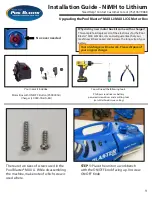
19
POOR CIRCULATION
* Dirty and clogged filter
* Skimmer baskets full of leaves, hair, debris etc
* Faulty pump
* Low speed pump
* Water level is low
* Cell is clogged with scale [refer to section 7(iii)]
FILTER PROBLEM
If the WATERMAID chlorinator is capable of registering 75 - 100%, but the pool or spa water
is cloudy, there may be a filter problem.
* Filter may need backwashing [refer to section 7(vii)][also refer to filter manual]
* Insufficient running times
* Body fat or oil build up on pads
* Sand filters: The sand in a sand filter should be changed every 5 years
* Diatomaceous earth filters: Insufficient diatomaceous earth over the pads
FOR EARLIER WATERMAID MODELS
For WATERMAID models manufactured prior to 2004, a solid green light indicates the
WATERMAID is producing chlorine and functioning correctly.
If the light stays red, it indicates one or more of the following:
> a deposit has formed on the Cell electrode(s) or its sensing tang (12mm metal tang
located at the top of the electrodes on the inside of the Cell) and requires cleaning [refer
section 7(iii)], or
> there is no water flow in the Cell, or
> the Cell On/Off switch is not on, or
> the wires inside the black terminal box connecting the Cell to the Power Supply are loose,
burnt, corroded or wired together incorrectly [refer to section 3(v)] or,
> the pool's salt level is low or,
> the Cell is at the end of its life.
For WATERMAID models manufactured before 1993, if the chlorinator is not
switched OFF when adding salt to the water, then undissolved salt may pass
through the Cell and cause the Power Supply to draw a higher current than
normal. As there is no overload protection in these units, damage may result.
(Continued)
Free Available Chlorine
pH
Total Alkalinity
Pools
1.0 - 3.0 ppm
7.2 - 7.8
100 - 200 ppm
Spas
3.0 - 5.0 ppm
7.2 - 7.8
100 - 200 ppm
1. ESSENTIALS FOR A HEALTHY POOL
Recommended daily levels for swimming pools and spas as determined by a test kit.
Check the expiry date on the test kit, as test results may be inaccurate if used after that date.
There are three fundamental requirements for maintaining a swimming pool or spa:
a) FILTRATION b) CHLORINATION c) pH
A pool or spa should be looked at daily to check that the water is clean and clear and the finest
details of the pool or spa walls can be seen at the deepest part. This will indicate
whether the
pool or spa has had enough filtration and chlorination for the load conditions that were
applicable
the day before.
Any other condition requires testing and rectification before entering
the water.
a) FILTRATION
It is first necessary to pass water through a filter to remove debris. A standard sized pool pump
with normal filter pressures will pump about 10,000 litres (2,642 gal) an hour, so an average
60,000 litre (15,850 gal) pool then requires six to ten hours of filtration a day in summer
conditions. This will turn over the equivalent of 1 1/2 times the total volume of water.
However,
about 65% only of the actual water and debris will have passed through the filter
. For
spas, the water typically turns over several times per hour with all of the water also going through
a filtration system (refer to owner's manual for details).
b) CHLORINATION
The WATERMAID pool chlorinator takes care of the chlorination. As mild saline water flows
through the WATERMAID Cell it is converted, by electrolysis, into chlorine as sodium hypochlorite.
Chlorine is required after filtration to react with any remaining debris (both visible and invisible),
remove stains by oxidation and sterilise the water of harmful bacteria.
A chlorine residual (or reserve) is required for any imminent bather load. A total of 1 to 3 ppm of
free available chlorine for pools and 3 to 5 ppm of free available chlorine for spas is required to
maintain a clean clear condition.
Because of its instability,
chlorine has a half-life of some 35 minutes
in strong sunlight and
even less in the presence of contaminants. Therefore, the use of a
chlorine stabiliser
is
strongly recommended
as it lengthens the half-life of chlorine to about 140 minutes and helps
maintain a chlorine residual in the pool on hot sunny days. At the beginning of the summer
season, chlorine stabiliser (Iso-cyanuric acid) should be added to the pool and circulated by
filtration.
Generally, at dawn and at dusk, wind dies down and
these are the best times to commence filtration.
Leaves and floating debris will be swept to the
skimmer box without restriction if the pool is well
designed.
Longer filtration cycles can reduce the chlorine
requirement and conversely, more chlorine can reduce
the filtration requirement.
For an average 60,000 litre (15,850 gal) pool, add 2
1/2 Kgs (approx. 6 lb) of chlorine stabiliser. After this
initial dose, the pool should be topped up with chlorine
stabiliser throughout the hot summer period to
maintain a level between 30 and 50 ppm. Factors
such as sunlight, filter and pump efficiency, stabiliser
level, bather load, debris, water temperature, salt
level, water level, chemical balance and age of the
Cell, ALL AFFECT THE FINAL CHLORINE LEVEL
.
2
FILTER & PUMP
60,000L
or
15850 gal
10,000 L / hr
2,642 gal / hr
6 - 10 hours / day
Recommended chlorine
stabilizer level: 30 - 50 ppm
Do NOT exceed 80 ppm
Note:
Indoor pools do not
require the addition of
chlorine stabilizer. Nor
do spas due to the
high turnover rate of
the water.






























